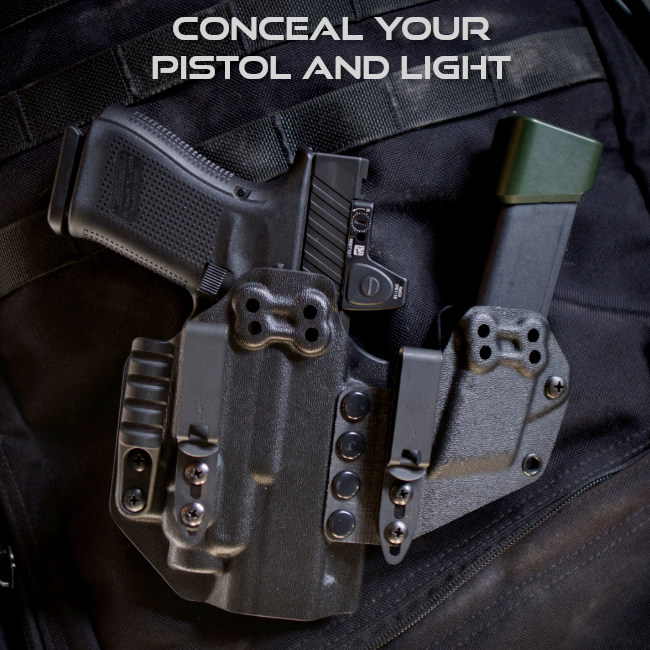You need a light. We know that violent encounters are more likely to happen in the dark, whether at night, or in unlit areas within your home or office. Proper lighting allows you to see your target, plus the foreground and background. You must properly identify your target before shooting. Let’s take a look at some examples of tragic shootings that may have been prevented.
Mistaken Shootings

In May 2019, a Pahrump Nevada man shot his 13-year old son. The son didn’t live with the father, and the dad missed a text saying the son would arrive Thursday night. The father heard a noise in the living room, leaving his bedroom, and firing a round into the figure moving toward the bedroom. The son’s injuries weren’t life threatening.
While the above story is tragic, the next one is heartbreaking.

In January 2022, a teenage girl was shot and killed by her father who mistook her for an intruder. This tragedy included a heartbreaking 8 minute 911 call where both mother and father can be heard begging for their daughter Janae Hairston to wake up. The house alarm had activated, and the father went into the garage to investigate at about 4am. Janae was pronounced dead at 5:42am.
Lest you think this couldn’t happen to you because you’re trained.

In October 2012, Michael Griffin, 48, was killed by his father – a retired Chicago police officer who mistook his son for a burglar. Michael was living with his father for a short time, went out sometime late Monday night or early Tuesday morning. When he came in the back door shortly after midnight, his father assumed Michael was sleeping, and assumed the person coming in was an intruder. Stephen Griffin, the father, was a cop for 42 years, including serving as a homicide detective.
Same thing, but with an off-duty Dallas officer

This officer and his son, names withheld, injured his son when mistaking him for an intruder. Thankfully the son’s injuries were not life threatening; he was bleeding from his arm.
This can happen during daylight hours in dark areas of the home.

A Cincinnati father shot and killed his 14-year son in January 2016, presuming him to be an intruder. This happened at 6:30am. The 14-year old had left for school, but returned. The father, hearing a noise in the basement, grabbed a handgun and investigated downstairs. The teen startled his father, who shot him in the neck.
More tragic stories:
https://people.com/human-interest/man-surprised-father-in-law-who-shot-and-accidentally-killed-him/
https://abcnews.go.com/US/drunk-teen-shot-stumbling-wrong-house-father/story?id=18764652
https://people.com/crime/colorado-man-allegedly-kills-son-believing-home-intruder/
So what do you, a responsible gun owner, do?
Always follow the rules of handgun safety:
- Treat all firearms as if they are loaded
- Never point your firearm at anything you’re not willing to destroy
- Finger off the trigger until your sights are on target and you’re ready to shoot
- Know the target foreground and background
Get a light
If you have insufficient lighting, you’re already breaking two of these rules. A light allows you to see whether you’re pointing your weapon in a safe direction. It also allows you to visualize the target foreground and background.
Thus, a light source is needed. This can be daylight, ambient lighting, a flashlight, or a weapon-mounted light. Or better, a combination of these items.
Responsible firearm ownership and use requires that you fully identify your target before using your firearms. Get a light.







Hello,
I enjoy your articles and look forward to getting them in my emails.
My son recently graduated from our local police academy and during his training they emphasized how important it is to use a light option other than a light on a firearm to identify a person or object in the dark.
Apparently nerves in a stressful situation could lead to a negligent discharge because most weapon lights on switches are close to the trigger of the gun.
They also suggested using your thumb to engage the light on your weapon.
My son demonstrated how they trained him to use an additional light source with his gun and when and if the threat presented itself he would go straight to the gun light.
I’m thinking of purchasing an additional light source to train with in tandem with my firearm light, are there some lights that you would recommend to me for this application?
Thank you once again for your articles.
David
David, yes. In short, a weapon light is not for general administrative use; you don’t want to point the gun at things you are trying to identify. Also bear in mind that police often need to use a light for searching in areas that may not contain threats, which is very different from you hearing a “bump in the night” inside your home. That said, there are techniques for using a weapon light for PID that do not necessarily violate the firearms safety rules — baseboard and umbrella lighting. And yes, I almost always activate a pistol light with my reaction hand thumb. For handheld lights, I think we have some articles and videos on them. Techniques for transition: https://youtu.be/TItX0CWVJmA and an EDC light comparison https://youtu.be/izwY7e7ydCo to show only a couple. We may have more handheld videos and articles in the future. Hope that helps!